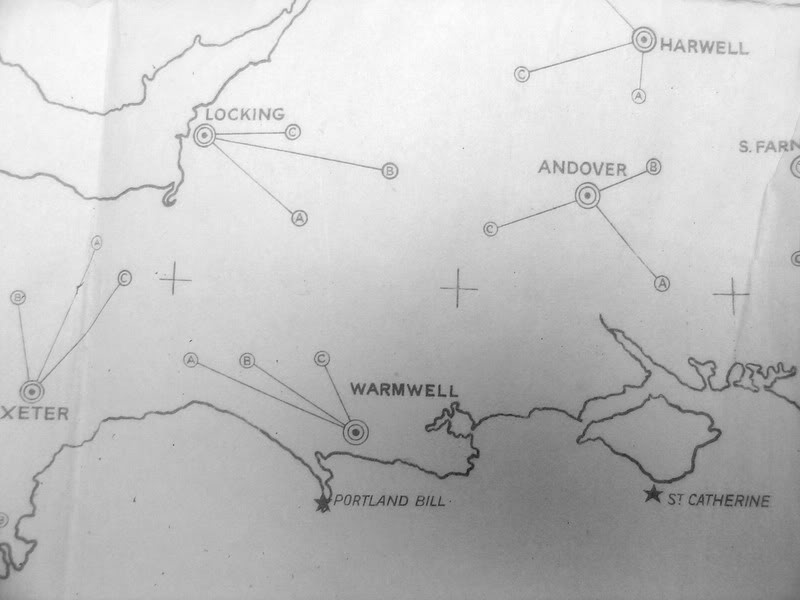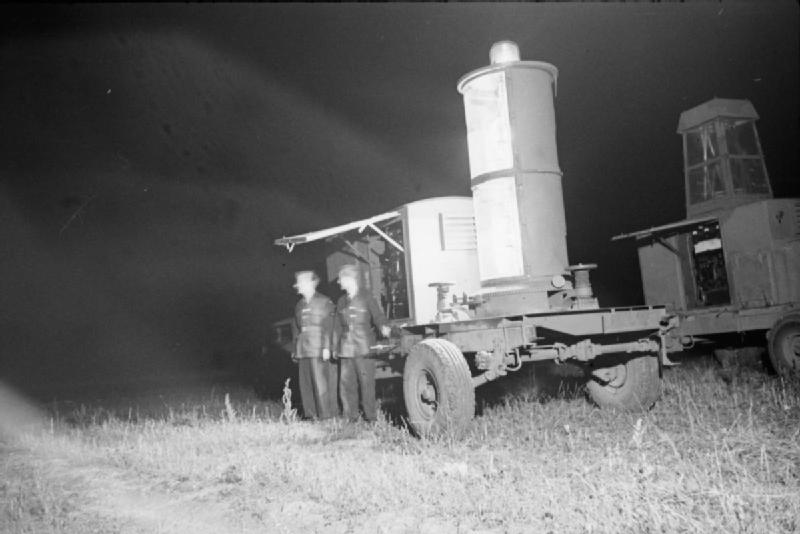Pundit Light on:
[Wikipedia]
[Google]
[Amazon]
 A Pundit Beacon or Landmark Beacon was an
A Pundit Beacon or Landmark Beacon was an
 A Pundit Light was a mobile Pundit Beacon.
As well as the obvious ability to move these mobile lights to temporary airfields they were also used to camouflage the airfield location from the enemy. The normal peacetime beacon location or light code was no longer used. Instead a mobile light was placed at one of three positions some distance from the airfield and a different wartime code was used: Elmdon () used / / in war, Ringway () used / / . The codes and their offset to the airfield location were distributed to flight crews and would change periodically. If an air raid was in progress at the airfield and so returning aircraft should divert elsewhere, its light location would also indicate this by also displaying a triangle of red lights surrounding it.
A Pundit Light was a mobile Pundit Beacon.
As well as the obvious ability to move these mobile lights to temporary airfields they were also used to camouflage the airfield location from the enemy. The normal peacetime beacon location or light code was no longer used. Instead a mobile light was placed at one of three positions some distance from the airfield and a different wartime code was used: Elmdon () used / / in war, Ringway () used / / . The codes and their offset to the airfield location were distributed to flight crews and would change periodically. If an air raid was in progress at the airfield and so returning aircraft should divert elsewhere, its light location would also indicate this by also displaying a triangle of red lights surrounding it.
 The beacons were trailer-mounted. The beacon light itself consisted of eight 400 watt red
The beacons were trailer-mounted. The beacon light itself consisted of eight 400 watt red
 The Aerial Lighthouse was used pre-war as a navigational beacons, as part of the Occult system. They indicated air routes and navigational markers, rather than airfields.
Each lighthouse signalled a single Morse letter. This letter was visible for around , and was unique within a radius. Like the Pundit Light, they were also trailer-mounted with a generator set, but used a single continuous white lamp with the flashing provided by rotating shutters.
The Aerial Lighthouse was used pre-war as a navigational beacons, as part of the Occult system. They indicated air routes and navigational markers, rather than airfields.
Each lighthouse signalled a single Morse letter. This letter was visible for around , and was unique within a radius. Like the Pundit Light, they were also trailer-mounted with a generator set, but used a single continuous white lamp with the flashing provided by rotating shutters.
 A Pundit Beacon or Landmark Beacon was an
A Pundit Beacon or Landmark Beacon was an airfield
An aerodrome ( Commonwealth English) or airdrome (American English) is a location from which aircraft flight operations take place, regardless of whether they involve air cargo, passengers, or neither, and regardless of whether it is for pub ...
navigational and identification beacon, used by the British Royal Air Force
The Royal Air Force (RAF) is the United Kingdom's air and space force. It was formed towards the end of the First World War on 1 April 1918, becoming the first independent air force in the world, by regrouping the Royal Flying Corps (RFC) an ...
(RAF) in the period around World War II.
Pundit Code
Each airfield was allocated a unique two letter Pundit Code, usually based on the name of the site, such as '' forRAF Beaulieu
Royal Air Force Beaulieu or more simply RAF Beaulieu is a former Royal Air Force Royal Air Force station, station in the New Forest, Hampshire, England. It was also known as Beaulieu airfield, Beaulieu aerodrome and USAAF Station AAF 408. It is l ...
. By the mid-war period the increasing number of airfields led to overlapping names. New codes were allocated by using the previously little-needed letters '', '', '', '', '', '' or ''. Harrowbeer thus became ''. Some pre-war beacons had initially used a single letter code, but these were re-allocated two letter codes to avoid confusion with the lighthouse beacons.
Codes were visible from the air, with high letters displayed alongside the Signals Square and Watch Office, usually near the control tower
Air traffic control (ATC) is a service provided by ground-based air traffic controllers who direct aircraft on the ground and through a given section of controlled airspace, and can provide advisory services to aircraft in non-controlled airs ...
. Established airfields had concrete letters set into the grass, as still survive at Beaulieu. Temporary or hurriedly constructed airfields used simple white paint on the tarmac.
Pundit Beacon
By 1937, all airfields used for night flying were also equipped with a Pundit Beacon. This used red lamps to flash the two-letter Pundit Code inMorse
Morse may refer to:
People
* Morse (surname)
* Morse Goodman (1917-1993), Anglican Bishop of Calgary, Canada
* Morse Robb (1902–1992), Canadian inventor and entrepreneur
Geography Antarctica
* Cape Morse, Wilkes Land
* Mount Morse, Churchi ...
. The beacon was visible all around in azimuth
An azimuth (; from ar, اَلسُّمُوت, as-sumūt, the directions) is an angular measurement in a spherical coordinate system. More specifically, it is the horizontal angle from a cardinal direction, most commonly north.
Mathematical ...
. The Morse code sequence was programmed for each beacon with a disc sequencer, a rotating disc with a ring of brass studs placed into it.
During wartime the red beacon became a familiar marker for returning bomber crews, signalling the end of a mission.
Pundit Light
 A Pundit Light was a mobile Pundit Beacon.
As well as the obvious ability to move these mobile lights to temporary airfields they were also used to camouflage the airfield location from the enemy. The normal peacetime beacon location or light code was no longer used. Instead a mobile light was placed at one of three positions some distance from the airfield and a different wartime code was used: Elmdon () used / / in war, Ringway () used / / . The codes and their offset to the airfield location were distributed to flight crews and would change periodically. If an air raid was in progress at the airfield and so returning aircraft should divert elsewhere, its light location would also indicate this by also displaying a triangle of red lights surrounding it.
A Pundit Light was a mobile Pundit Beacon.
As well as the obvious ability to move these mobile lights to temporary airfields they were also used to camouflage the airfield location from the enemy. The normal peacetime beacon location or light code was no longer used. Instead a mobile light was placed at one of three positions some distance from the airfield and a different wartime code was used: Elmdon () used / / in war, Ringway () used / / . The codes and their offset to the airfield location were distributed to flight crews and would change periodically. If an air raid was in progress at the airfield and so returning aircraft should divert elsewhere, its light location would also indicate this by also displaying a triangle of red lights surrounding it.
 The beacons were trailer-mounted. The beacon light itself consisted of eight 400 watt red
The beacons were trailer-mounted. The beacon light itself consisted of eight 400 watt red neon tube
Neon lighting consists of brightly glowing, electrified glass tubes or bulbs that contain rarefied neon or other gases. Neon lights are a type of cold cathode gas-discharge light. A neon tube is a sealed glass tube with a metal electrode a ...
s mounted in a glass pyramid lamp house. They were powered by a 16.9 bhp Coventry Climax
Coventry Climax was a British forklift truck, fire pump, racing, and other specialty engine manufacturer.
History
Pre WW1
The company was started in 1903 as Lee Stroyer, but two years later, following the departure of Stroyer, it was reloca ...
petrol engine-generator
An engine–generator is the combination of an electrical generator and an engine (prime mover) mounted together to form a single piece of equipment. This combination is also called an ''engine–generator set'' or a ''gen-set''. In many contexts ...
set driving a set of eight induction coils to produce the high voltage needed by the neon tubes. The complete engine-generator, Morse code sequencer and lamp house was carried on the trailer. In transit, the lamp house was carried on the rear of the generator housing to reduce overall height, then put in place once on site.
Pundit Lights were part of the cargo of the , a Merchant Navy ship sunk in the Red Sea
The Red Sea ( ar, البحر الأحمر - بحر القلزم, translit=Modern: al-Baḥr al-ʾAḥmar, Medieval: Baḥr al-Qulzum; or ; Coptic: ⲫⲓⲟⲙ ⲛ̀ϩⲁϩ ''Phiom Enhah'' or ⲫⲓⲟⲙ ⲛ̀ϣⲁⲣⲓ ''Phiom ǹšari''; ...
in 1941, whilst en route to the Western Desert Campaign in Egypt. The wreck site is now a popular scuba diving location and the lights can still be seen in the ship's cargo hold. The unusual shape of the light trailers has sometimes led to them being mis-identified as the more familiar Rolls-Royce armoured cars.
A later, two-wheeled Pundit Light on a standard Sankey trailer chassis is preserved at the Norfolk & Suffolk Aviation Museum, Flixton. These 1950s models were used on RAF bases in Germany into the 1980s and the end of the Cold War.
Aerial Lighthouse
 The Aerial Lighthouse was used pre-war as a navigational beacons, as part of the Occult system. They indicated air routes and navigational markers, rather than airfields.
Each lighthouse signalled a single Morse letter. This letter was visible for around , and was unique within a radius. Like the Pundit Light, they were also trailer-mounted with a generator set, but used a single continuous white lamp with the flashing provided by rotating shutters.
The Aerial Lighthouse was used pre-war as a navigational beacons, as part of the Occult system. They indicated air routes and navigational markers, rather than airfields.
Each lighthouse signalled a single Morse letter. This letter was visible for around , and was unique within a radius. Like the Pundit Light, they were also trailer-mounted with a generator set, but used a single continuous white lamp with the flashing provided by rotating shutters.
See also
*List of former Royal Air Force stations
This list of former RAF stations includes most of the stations, airfields and administrative headquarters previously used by the Royal Air Force.
The stations are listed under any former county or country name which was appropriate for the du ...
, together with their Pundit codes
References
{{Reflist World War II military equipment of the United Kingdom Air navigation History of the Royal Air Force during World War II